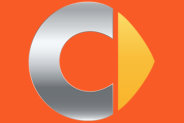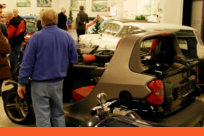

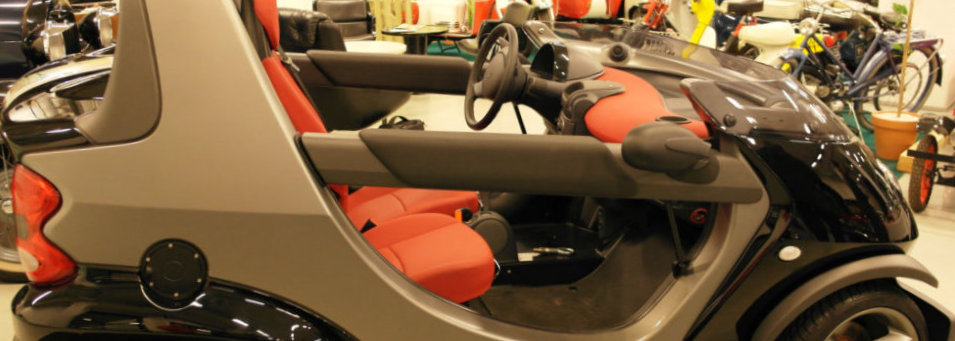

MoMa New York holds Smart in the permanent collection

Smart ForTwo
Crossblade - 02
A 2002 limited-edition variant of the city cabrio, a
roadster without a windshield, roof or conventional
doors. Its weight was still 740 kilograms (1,630 lb). The
Brabus-tuned engine developed 52 kW (71 PS) from its
599 cc engine. After Robbie Williams purchased
Crossblade number 008, Smart began a marketing
association with him, using him to promote the brand and
the new Forfour.
The Smart Fortwo is a rear-engine, rear-wheel-drive, two-passenger, two-door city car manufactured and marketed by the Smart division of Daimler AG, introduced in 1998, now transitioning into its third generation. Marketed in 46[2] countries—in Asia, North and South America, Africa, Australia and Europe—production of the Fortwo had surpassed 1.7 million units by early 2015. The Fortwo is noted for its 2.69 meter overall length, high H-point seating, offset passenger and driver seats (in the first and second generation, the passenger seat is 15 centimetres further rearward than the driver’s), automated manual transmission (1st and 2nd generation), De Dion tube rear suspension, low CO2 emissions (119 grams per kilometre, North America, 1.0 Liter), two-part rear hatch, interchangeable plastic body panels and prominent steel hemispherical safety-cell, which is marketed as the Tridion cell and is often provided in a contrasting color to the vehicle's body panels. Fortwo models are manufactured at Smartville—a dedicated Daimler assembly plant in Hambach, France—in Coupé (i.e., hatchback) and Cabrio (i.e., convertible) body styles, each in a mono-box configuration. Generations are internally designated as the W450 build series, introduced at the 1998 Paris Motor Show, and the W451 build series, introduced at the 2006 Bologna Motor Show. Smartville underwent a 200 million euro upgrade beginning in mid-2013 for the third generation Fortwo (2014–), internally designated as the C453 build series. The third generation Fortwo made its formal global debut on July 16, 2014 at the Tempodrom in Berlin along with a closely related four-door version, the Smart Forfour, co-developed and sharing the same platform and engines with the third generation Renault Twingo. With the second generation, Smart introduced a version with automatic start-stop, marketed as the MHD, or Micro-Hyrbrid Drive—offered only in certain markets. A sport model, marketed as the Brabus model, has been available in both generations, and Daimler introduced the Smart electric drive, an all-electric version, in 2007. The Fortwo forms the basis for Daimlers Car2go fleet, the largest car-sharing enterprise worldwide. In 2002, the New York Museum of Modern Art (MoMa) introduced a first generation Fortwo into its permanent collection (the only vehicle to be included into the collection while still in series production), and in 2014 the Fortwo was voted the Best Microcar for the fifth year in a row by readers of the Chinese edition of Auto, Motor und Sport. The Smart Fortwo diesel-engined variant, the Cdi, has the world's lowest carbon dioxide emissions for an internal combustion engine, at 88 grams per kilometer. The brand name Smart derives from its early history as a cooperative venture between Swatch and Mercedes: Swatch Mercedes ART. The Fortwo nameplate derives from its two-person seating capacity. Until 2004, the Fortwo had been marketed as the smart City-Coupé.Features
The 2001 marketing brochure for the W450 build series cites a .37 drag coefficient. Auto Motor und Sport cites a drag coefficient (Cd) of .35 and Alles Auto cites a Cd of .345 for the second generation W451 series For comparison, the current Fiat 500 offers a .38 Cd and the first generation Honda Insight offers a Cd of .29. The W450 and W451 series each have a frontal area of 1.95 square meters and 2.057 square meters respectively.Automated manual transmission
The Fortwo employs a automated manual transmission, designed and manufactured by Getrag, that eliminates the clutch pedal. The first generation used a six-speed version, and the second generation uses a five-speed version, model 5AMT130. Input from floor-mounted shifter or optional steering-wheel-mounted paddles controls a servo-operated clutch and sequential automated gearbox. The vehicle may be driven in automatic mode or via paddle shifters, where the operator controls the shift points but cannot feather or adjust the speed of the clutch. From 2009, revised transmission software enabled smoother and faster gear changes. The software, available via an ECU upgrade, was also made available for 2008 second generation cars, with a new battery as required.Parking
With an overall length (first generation: 2.5 m (98.4 in)) approximately equal to the width of regular parking space, a smart Fortwo can park perpendicularly in spaces typically designed for parallel parking, allowing two Smarts to park in one space—a manner of parking not permissible in many jurisdictions worldwide (e.g., Munich, Germany, and California).First generation (Build series W450, 1998–2007)
The first generation, build series W450, debuted in 1998 and received a facelift in 2002.Engine
The engines are turbocharged with three cylinders. Originally the basic petrol engine was 599 cc, and came in three versions—45 hp (33 kW), 51 hp (41 kW) and 61 hp (45 kW). The engine displacement was increased to 698 cc with the facelift in 2002, in 37 kW (50 hp) and 45 kW (61 hp) variants. The turbo-diesel engine had 799 cc displacement giving 30 kW (41 hp).Models
The Fortwo is available as a coupe or cabriolet, originally called the "city coupe" & "city cabrio", now the "Fortwo" & "Fortwo cabrio", introduced in 2000 and restyled in 2002. Trim levels include the Pure, Pulse, and Passion. • Limited 1: The first limited edition of which 7500 were made. All left-hand drive. Released at the original launch in 1998. Black Tridion cell and White body panels. Alloy wheels, Limited 1 insignia, blue interior with beige leather finishings. Supplied with certificate showing which number out of the 7500, and a plaque with this number below the windshield on the inside. • SE: This was the second limited edition that smart made, it was sold in mid 2001 (Mk5) and all were left hand drive. They were all Pulse specification with a redesigned steering wheel, soft touch, air conditioning, CD Multichanger and drinks holder as standard. The engine power was upped to 61BHP from the standard 55BHP normally applied to the Pulse in the 600cc G1 cars. It was designated by a SE badge on the boot and was sold in Bay Grey with grey interior and dark blue twist fabric. • Cdi: has the world's smallest production car diesel engine, which uses common-rail direct injection. With a consumption of 3.3 litres (NEDC) per 100 kilometres (71.2 mpg) and CO2 emissions of just 88 grams per kilometre, it has the lowest current production car CO2 emissions worldwide, since Audi and Volkswagen retired "3 litre" cars, the A2 1.2 TDI and the Lupo 1.2 TDI respectively. • Crossblade: a 2002 limited-edition variant of the city cabrio, a roadster without a windshield, roof or conventional doors. Its weight was still 740 kilograms (1,630 lb). The Brabus-tuned engine developed 52 kW (71 PS) from its 599 cc engine. After Robbie Williams purchased Crossblade number 008, Smart began a marketing association with him, using him to promote the brand and the new Forfour. • Crosstown: a convertible with a foldable windshield based on the Fortwo, was presented at IAA Frankfurt in 2005. No plans have yet been announced to bring this model to market. • Nightrun: includes instrument panels, steering wheel, paddles, shifter, Monoblock VI alloy wheels, leather seats and engine upgrade from Brabus. Edition Nightrun is only available with the Fortwo coupé. • Truestyle: painted in metallic ruby red, available in pure trim. • i-move: a special edition run of 70 Fortwo cabrios, based on the Passion cabrio specs with Brabus Monobloc VI wheels, leather interior trim, Lite White panels, an iPod cradle with special edition 20Gb 3G iPod, and an aluminium name plate on the dash confirmed its special edition status. • Forfun2 Concept: an off-road version of the Fortwo introduced at the 2005 Athens Motor Show by Greek 4x4 Rally Champion Stefan Attart. It combines the body of a Fortwo with the chassis and drivetrain of a Unimog. It sports monster truck-like 26-inch wheels wrapped in 1.4 m diameter tires and winding keys where the Fortwo's rear wheels are supposed to be. • Brabus: In 2003 Smart and Brabus introduced the jointly developed version of the Fortwo with the 698cc engine. It had 75 PS (55 kW; 74 hp) of power and 110 Nm of torque. It was available in both coupe and convertible versions. It also featured wider wheels, revised front spoiler and grille, and a revised rear exhaust. • K: launched in October 2001, exclusively for the Japanese market. It was designed to fit the Japanese kei car regulations by adopting specially developed rear fenders and narrowing the track width and tire dimensions and the width reduced to 1.47 m. The engine displacement remains unchanged at 598 cc, as specified in the standard. Safety features include ESP (Electronic Stability Program) and BAS (Brake Assist System) as standard. The Smart K also facilitates the starting procedure with the Hill Start Assist that makes a starts on slopes easier. The Smart K was discontinued in November 2004. • Fortwo Edition Limited One: Featured special metallic grey body panels; silver Tridion cell; brown leather for the seating, steering wheel, and shift lever—along with matching floor mats. The model marked the launch of the W451 build series.
2002
Engine 700 cc 3-cylinder 75 htp The collections Crossblade has been driven only 2000 km and it is number 1807 of 2000 cars made.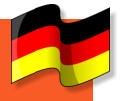
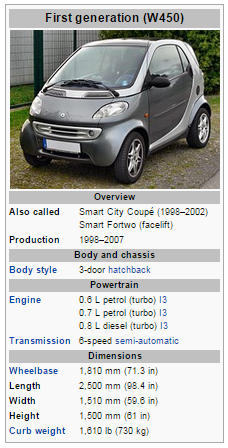
Photos mainly by Matti Kreivilä. Historical facts and technical details of the vehicles provided by Wikipedia. Movies YouTube.


- Decade of 60's
- Austin 850 Pickup - 1962
- Chaika Tshaika 13 GAZ - 1962
- Citroen 2CV - 1961
- DKW Junior - 1961
- Fiat 1100 - 1963
- Ford Taunus 12M - 1961
- GLAS 1204 - 1963
- MG 1100 - 1964
- Moskvich 407 - 1961
- Nagetusch caravan - 1961
- NSU Printz 4 - 1961
- Opel Kadett A - 1964
- Panhard PL17 - 1961
- Peugeot 404 - 1962
- Renault Dauphine - 1965
- Simca Aronde P60 - 1960
- Simca 1000 - 1966


